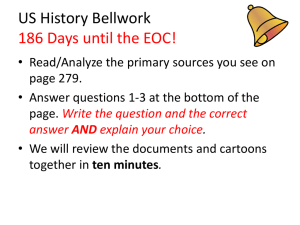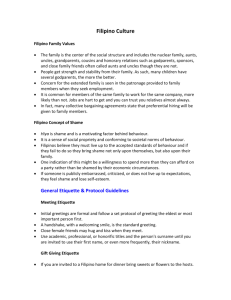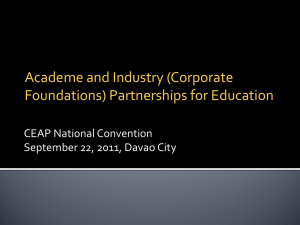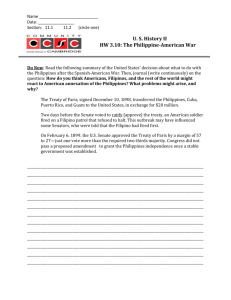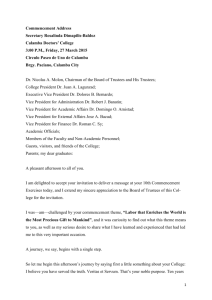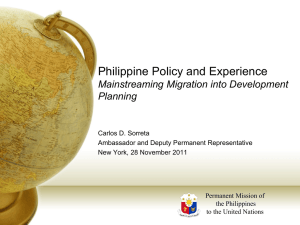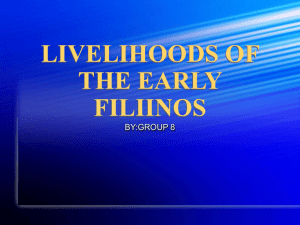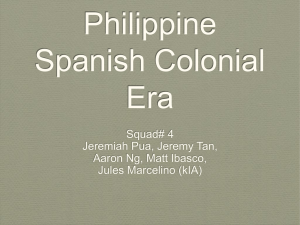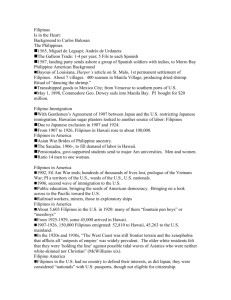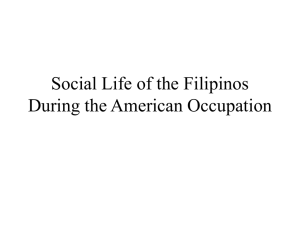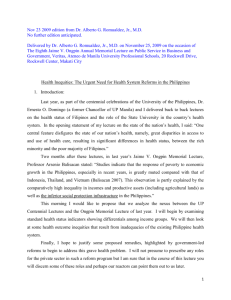Philippine-American War: Guilt, Shame, or Amnesia?
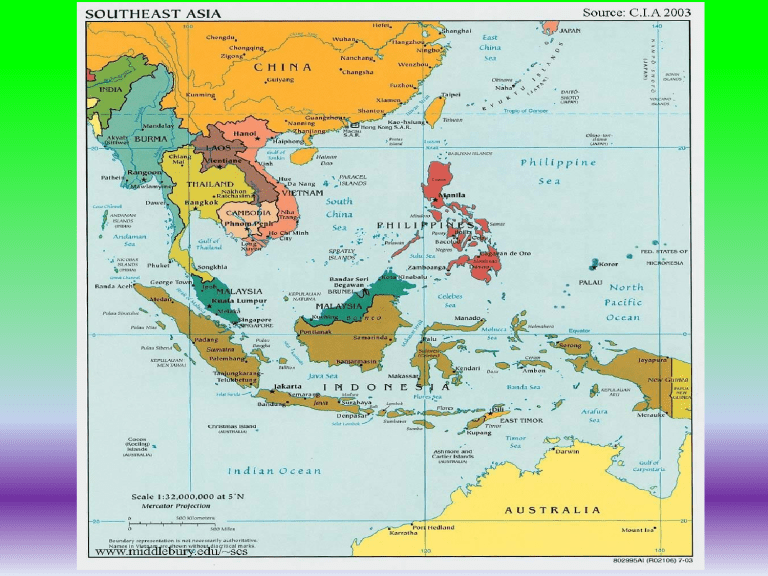
A Case of Guilt, Shame, or
Amnesia?
The Philippine-American War
Kevin M. Mariano
5 Focus Questions
What lessons can be learned from studying the Philippine-American War and should it be more of a focus in American public education? Explain.
•
Explain the impact that guerilla tactics had on both the Americans and Filipinos.
•
Why did Gen. Emilio Aguinaldo try to appeal to both the American government and the American public?
•
Determine if the Philippine-American war is a case of "Guilt, Shame, or Amnesia" for the American public and how this should be addressed?
•
Examine the use of learning with textbooks and learning with primary sources: why is it valuable to learn from different sources and why are textbooks often limited in their information?
Spanish American War
Background (Review)
•1854 U.S. wants to buy Cuba from Spain
•1886 American Sugar Plantations
•1895 Cuban revolutionaries destroy American property why?
•General “Butcher” Weyler
•Yellow Journalism
•DeLome Letter Scandal
•U.S.S. Maine
“REMEMBER THE MAINE!”
• Feb 18,1898 USS Maine suddenly blows up in Havana Harbor
• 260+ US men died
• Cause? Initially, people thought that Spain was responsible
• $50,000 reward!
Yellow Journalism
• A type of journalism that downplays legitimate news in favor of eyecatching headlines that sell
Spanish-American War
•April 1898 McKinley asks Congress for permission to use force against Spain
The Philippines
•11,000 Americans joined forces with
Filipino rebels
•George Dewey – friends with T. Roosevelt.
commander of Navy’s Asiatic squadron –
May 1 st : enters Manila Bay with superior fire power – Spanish surrender in 1 day – 381
Spanish dead – 1 American dead
DATES OF CONFLICT:
BEGAN: February 4, 1899
ENDED: July 4, 1902 (This is the "official" end of the war, as proclaimed by U.S.
President Theodore Roosevelt. Fighting continued on several islands for years to come.)
CAUSES: the U.S. government's quest for an overseas empire and the desire of the Filipino people for freedom a clash between the forces of imperialism and nationalism.
CASUALTY FIGURES (estimated):
U.S.-- 4,234 dead and 2,818 wounded. Philippines-- 20,000 military dead and
200,000 civilian dead
Some historians place the numbers of civilian dead at 500,000 or higher.
UNIQUE FACTS OR TRENDS:
1.
This was the first major land campaign fought by the U.S. outside of the
Western Hemisphere.
2. The Philippine-American War can be considered America's first
"Imperialistic" conflict.
Philippines
• Annexation of the Philippines – McKinley said
“must take them all and educate the Filipinos and uplift and Christianize them” Philippines becomes central issue around which U.S. imperialism is debated – Feb. 1899 Philippines annexed by U.S.
• Philippine-American War – Jan. 1899 Emilio
Aguinaldo declares Philippines independent Feb. armed conflict – Guerilla Warfare
When else was the U.S. involved in conflict against native peoples?
How was this fight different?
1. No reservations (to settle on)
2. No railroads/American settlers
3. Must pacify Filipinos not just defeat them b/c US citizens are not “moving there”
USA Artillery v.
Filipino Artillery
Guerrilla Warfare
• the irregular warfare and combat in which a small group of combatants use mobile military tactics in the form of ambushes and raids to combat a larger and less mobile formal army
Balangiga Massacre, September 28, 1901
• Company C, 9th US Infantry = 1 st month = fraternization with
Filipinos (romance, parties, baseball, competitions/demonstrations)
• September 22, 1901- Two drunken US soldiers molest Filipino girl girl’s two brothers mauled the men, not killed
• Valeriano Abanador – local chief, mastermind of Filipino guerilla attack
•
• - Women/children escorted out in the middle of the night
- August 28 th , at 6:45am: 34 Filipinos cross dressed “as worshipers” Abanador stole US soldier’s gun, hit him in the head, and yelled,“Atake, mga Balangigan-on! (Attack, men of
Balangiga!).
• A bell in the church tower was rung seconds later, to announce that the attack had begun.
• 500 Filipinos hack Americans to death; close combat
• Most Americans initially defend themselves with chairs, utensils
• Filipinos retreat when remaining US organize their weapons
Effects:
48 of 76 US men killed; of 26 remaining, 22 severely wounded
Filipinos also took 100 rifles with 25,000 rounds of ammunition; 28
Filipinos died and 22 were wounded
US wants revenge
US public shocked
US newspapers: “…the worst disaster suffered by the U.S. Army since Custer's last stand at Little Big Horn.”
Maj. Gen. Adna R. Chaffee,( military governor for the “unpacified” areas of the
Philippines),to the media: “The situation calls for shot, shells and bayonets as the natives are not to be trusted… If you should hear of a few Filipinos more or less being put away don't grow too sentimental over it."
Chaffee informed his officers that it was his intention "to give the Filipinos 'bayonet rule' for years to come."
President Theodore Roosevelt ordered Chaffee to adopt "in no unmistakable terms," the "most stern measures to pacify Samar."
After the massacre at Balangiga, US General Smith issued his infamous Circular No.
6, and ordered his command thus: "I want no prisoners" and "I wish you to kill and burn; and the more you burn and kill, the better it will please me." Then he tasked his men to reduce Samar into a "howling wilderness," to kill anyone 10 years old and above capable of bearing arms.
How did America try to pacify the
Filipinos?
1.
“Civilization”: Built railroads, telegraph lines, telephone lines, schools bridges (but did Filip. want/need this? Who does it
“really” help?)
2.
Torture, called Filipinos “niggers” or “gugus,” massacred, herded
300,000 civilians into concentration camps
The “Cost” of Philippine- American War
• (From class text: The Americans. McDougal Littell. Evanston,
Illinois. 1998): “20,000 Filipinos rebels die” // 4,000 US”
– San Juan, Jr. Article: 1.4 million Filipinos died (1,400,000) who is telling the truth?
• $400 million = 20 times what the US paid for the islands
• Anti-Americanism
• Growing Racism
• New Resources to US
• Geographically: greater presence in Asia
(China. Boxer Rebellion) http://waterboarding
.org/firsthand
Assessment
(use at least four sources overall)
• With this background knowledge, use the primary sources, and the San Juan Jr. Article, to answer either of the following Inquiry
Questions in essay format:
What lessons can be learned from studying the Philippine-
American War and should it be more of a focus in American public education? Explain.
Determine if the Philippine-American war is a case of "Guilt,
Shame, or Amnesia" for the American public and how this should be addressed?
